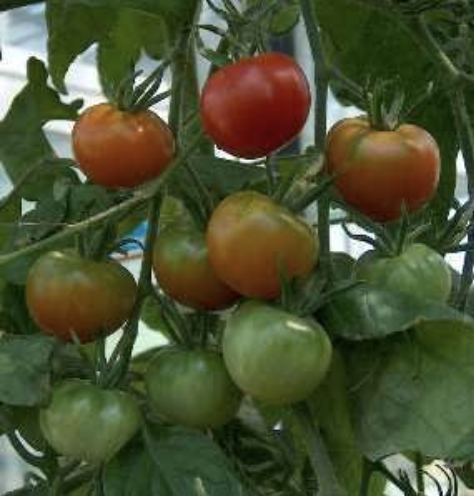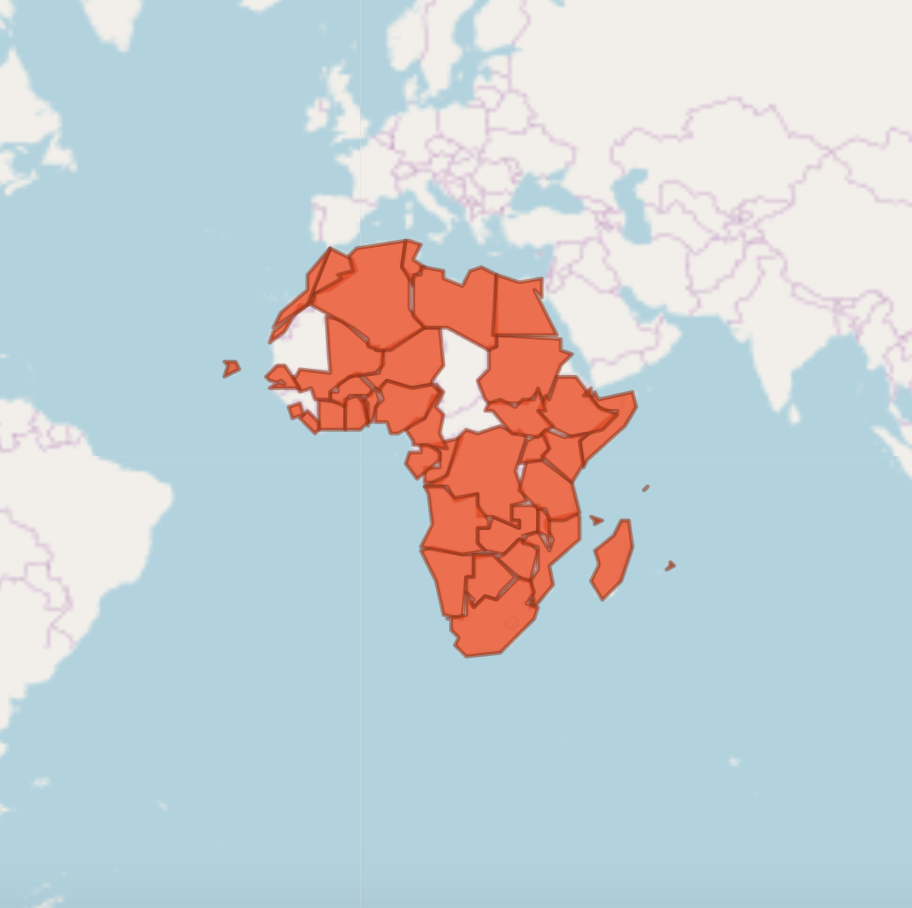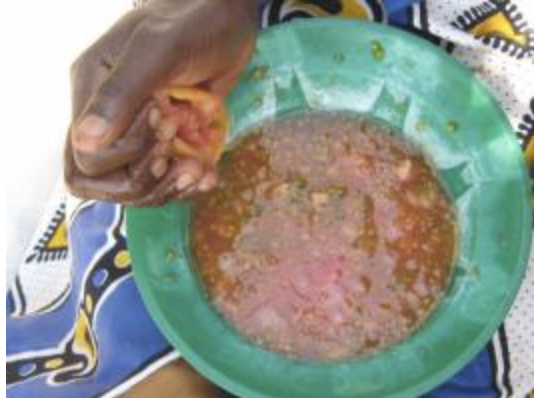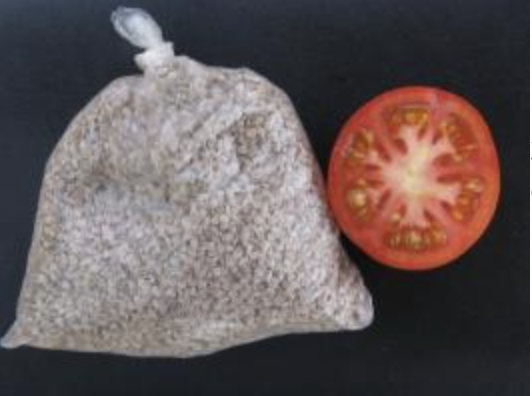
(c) Simone Hunziker
Scientific Name: Lycopersicon esculentum
Order / Family: Solanales: Solanaceae
Local Names: Nyanya (Swahili)
1. Geographical Distribution in Africa

2. General Information and Agronomic Aspects
Tomatoes are native to South and Central America, and are now cultivated widely throughout the world.
Tomatoes are one of the most widely cultivated vegetable crops in Africa. They are grown for home consumption in the backyard of almost every homestead across sub-Saharan Africa. They are important source of vitamins and an important cash crop for both smallholders and medium-scale commercial farmers. Tomatoes acting as taste enhancers in food are always in high demand both for fresh consumption and processing.
Tomato yields in smallholder cropping systems in the region are generally far below the potential of the crop. Average yields as low as 7 tons/ha have been reported from Tanzania and 10 tons/ha from Uganda, while yields as high as 100 tons/ha have been recorded from commercial farmers in Zimbabwe. There are several reasons for low yields. Among these are low quality seeds, non-availability of inputs, sub-optimum crop husbandry and a large number of pests and diseases.
Cherry Tomatoes are a fast expanding export crop in Kenya. These are miniature tomatoes with a preferred size of around 15 g per fruit. Cherry tomatoes are easier to grow organically than most other tomatoes as many of them have a high tolerance to diseases and can be grown successfully both under green house and open field conditions.
Climate conditions, soil and water management
Ideally, tomato requires a relatively cool, dry climate for high yield and premium quality. However, it is adapted to a wide range of climatic conditions. Tomatoes have been grown as far north as the Arctic Circle (under protection) and down to the hot and humid equator. The optimum temperature range for growth and development is 21 to 24degC. Prolonged exposure to temperatures below 12degC can cause chilling injury. Mean temperatures above 27degC severely impair growth and fruit set. Destruction of pollen and egg cells occurs when the maximum day-time temperature is 38 deg C or above for 5 to 10 days. Fruit set is also generally poor if the night temperatures are above 21 deg C just before and after flower formation. Hot dry winds can also cause flower abortion. Tomatoes are not sensitive to day length and set fruits in photoperiods ranging from 7 to 19 hours. Tomatoes can be grown in many soil types ranging from sandy loam to clay-loam soils that are rich in organic matter. The ideal soil pH range is 6 to 6.5; higher or lower pH can cause mineral deficiencies or toxicities. Long periods of flooding are detrimental to tomato growth and development.
Small-holder farmer tomato seed production
For own seed production it is not recommended to use hybrid varieties. These varieties carry a label “F1”. However, if a hybrid variety is preferred, it cannot be used for more than one generation (one crop cycle).
Conditions to be followed when producing seed:
- The tomato seed should be multiplied only once.
- Buffer zone for tomato seed plot should be 25 m from any other tomato crop.
- The plot should not previously have had tomatoes planted recently.
- The tomato crop should be scouted regularly for pests and diseases.
- The first step fruits should not be included for seed extraction.
- After planting the seed the off types should be uprooted early as when seen.
- Weeding of plot should be properly done.
- Proper crop management is needed i.e. fertiliser application, pruning, staking irrigation etc.
Seed extraction process

(c) A.A. Seif, icipe
- Pick ripe fruit at second cluster from only robust, disease-free plants (plants not infected with diseases: bacterial canker / bacterial speck / bacterial spot / anthracnose fruit rot / early blight / late blight / tomato mosaic virus).
- Wash the fruit, preferably with a soap (potassium based) to decrease the chance of infection by diseases.
- Cut the fruit in two pieces and remove the seeds with a spoon. Or the pieces can be squeezed out into a clean bucket, plastic, glass or ceramic bowl until only the seed-jelly and fruit sap is left.
- Cover the bowl with cloth or paper to keep away dirt and other possible contaminants but do not make it airtight.
- Let the seeds stand for 1 to 5 days (usually 2 to 3 days in warm areas).

(c) A.A. Seif, icipe
- Stir the seeds daily to ensure uniform fermentation and to prevent seed discolouration.
- Wash the fermented seeds in clean water. Any seeds that float during washing should be discarded because they are either not fully ripened or filled properly.
- Dry the seeds in indirect light and in well-ventilated places. The seeds could be spread out over a clean manila sack to dry.
In case seeds cannot be sown immediately, they should be stored in a waterproof container (transparent plastic bag / non-coloured glass bottle). Transparent materials allow sunlight, which reduces mould development. Place a bit of ashes in the bottom of the container to absorb any moisture and to prevent the seeds from moulding. In case where pots or bottles are used for seed storage, the tops should be covered with plastic film to stop possible water seepage and mite infestation.
- Store seed container in a cool place, as dry as possible.
- Check the seeds regularly (at least weekly) for mould development. If mould is detected, dry the seeds again.

(c) A.A. Seif, icipe
Seeds can be stored, if properly dried, up to 2 years.
One kg of tomatoes will produce between 1 and 4 grams of seeds.
(This information is based on a Biovision Project carried out in Taita Hills, Kenya, under Eastern Arc Mountains in conjunction with Wild Life Services)
Propagation and planting
Tomatoes can be direct-seeded or transplanted in the field, but this method is expensive as large amounts of seed are required (about 500 to 1000 g of seeds/ ha) and adds about four weeks of weeding labour to growing costs. In contrast, raising the young transplants in a special nursery enables growers to achieve great seedling uniformity, requires smaller quantity of seed and saves on weeding costs.
Nursery bed preparation:
- Construct raised seedbeds of maximum one m width in a place where no potatoes, tomatoes, eggplants or peppers have been grown for about 3 years.
- Incorporate about 5 kg of good compost/ m2 into the seedbeds, which are finely cultivated on top.
- Drill shallow seeding furrows with a pointed stick. One ha of tomatoes requires 150 to 200 g of well germinating seed.
- Sow seeds in the furrows and cover them lightly with soil.
- Pat firmly with the flat side of a rake or similar tool, mulch and water liberally.
- Never use fresh manure on a seed bed as it will burn young seedlings.
- After emergence of seedlings push away the mulch from the rows to allow sunlight to get through to the young seedlings.
- Individual plant raising in banana leaf pots or plastic seedling trays will greatly improve eventual plant establishment, by reducing transplanting shock and root damage during transplanting.
- The young seedlings require sufficient water to sustain good, healthy growth.A week before transplanting, reduce watering to harden the seedlings. Three- to four-week-old seedlings (15 to 25 cm high with 3 to 5 true leaves) are ready for transplanting. Seedlings must be thoroughly watered 12 to 14 hours before they are lifted out of the seedbed, to avoid excessive damage to the roots. Transplant seedlings in the afternoon or on a still, cloudy day to reduce the transplanting shock, and water them immediately. As little as a cup of water per plant immediately at planting will greatly speed up plant establishment.
- Spacing between plants and distance between rows depends on the cultivar’s growth habit and whether the plants are to be supported by stakes or left to grow on the ground.
- Indeterminate varieties are generally staked while determinate varieties can be grown in the field without staking. Common configurations are plants spaced 30 to 60 cm apart in single or double rows on 1.0 to 1.4 m wide beds.
Husbandry
Tomatoes respond very well to liberal amounts of well-rotted compost or manure. In addition a spoonful (or 3 teaspoons) of rock phosphate should be added to each planting hole. If the soil is poor in organic matter it is advisable to grow a crop of good quality green manure such as cowpeas, mucuna, soybean, or crotalaria before transplanting tomato seedlings. Avoid commercial nitrogen fertilisers as excess nitrogen is associated with fruit puffiness and blossom-end rot, and generally causes excessive vegetative growth. Excess free nitrogen in the soil also causes softer leaves and makes the plants attractive to pests and diseases. Competition with weeds, especially in the hot and humid tropics, can be very severe. To control weeds on open land crops, slash regularly emerging weeds as close to the ground as possible between rows of tomatoes is recommended. Leave slashed weeds on the soil as mulch to help prevent erosion, reduce soil temperature and conserve soil moisture. This should be supplemented by manual weeding in rows and mulching the beds with straw.
Staking:
For tall growing indeterminate varieties, put a 2 m stake firmly in the ground for each tomato plant and tie the stems loosely as the plant grows. Alternatively put a stout pole in the ground at every four m and two wires run – 1 at 2 m and another one at 0,15 m above the ground. Tye a fairly strong string between the two wires behind each tomato plant. The plants can then be carefully twisted around the strings as they grow.
Pruning of tomato plants is necessary for indeterminate varieties. One or two main stems should be allowed to grow and the side branches (laterals) pinched off as the crop grown on a weekly basis. When 6 to 8 flower clusters are formed, the growing top should be pinched off to encourage the growth of good size marketable fruit. Leaves close to the ground should be removed to help prevent entry of blight infection. No pruning and regulation of fruit number and clusters are normally practised on determinate cultivars. Semi-determinate cultivars may be grown either as a determinate or indeterminate crop. Smokers should wash their hands carefully with soap before handling tomato plants as they may otherwise transmit tobacco mosaic virus disease.
Tomatoes need adequate irrigation during the early plant growth, fruit set and fruit enlargement stages. Consistency of water supply to the plants plays a major role in attaining uniform maturity. It also reduces the incidence of blossom-end rot, a physiological disorder normally attributed to calcium deficiency during fruit enlargement. In dry weather watering is essential at least two times a week. Drip irrigation is the most efficient and risk free method of irrigation, as it does not create water splashes onto the plants.
Cherry tomatoes although indeterminate can produce quite well even when not staked in the field, but must then be given adequate space as they spread quite extensively ( one m2 per plant is minimum). Higher production and easier field management are benefits of the expensive staking procedure.
Harvesting
Fresh-market tomatoes are often harvested at the mature-green stage and ripened in transit or in storage before they are marketed. Ethylene is sometimes used to rapidly and uniformly ripen mature-green tomatoes prior to shipping them to the market, but this adversely affects quality. This is not a common practice in Kenya. Generally, tomatoes harvested at pre-ripe stages tend to be of lower quality (lower soluble solids, ascorbic acid and reducing sugars) than plant-ripened tomatoes. The nature of the growth and ripening pattern of fresh-market tomato cultivars require frequent pickings for either mature-green or plant-ripe fruits. In contrast to the fresh-market or table tomatoes, processing tomatoes are picked fully ripe. In developed countries, harvesting is often by machine. Tomatoes used for pureed products such as soup, juice and sauces, are left on the plant until over 85% of the fruits are ripe. Those for whole tomatoes are picked while still firm, but often only 65% of the crop may be ready to be picked all at once.
After picking, tomatoes should be stored in a shady place either in the field or at home to prepare them for the market. Properly sorted and graded fruits generally command a better market price than ungraded fruits. The marketable fruits are then packaged in suitable containers, often 20-kg wooden boxes, bamboo baskets, plastic boxes, or other locally available packaging materials. Proper packaging protects fruits from injury and reduces water loss. The storage life of tomatoes depends on the maturity stage at which they are harvested and on the desired quality of fruits. Quality is highest when completely ripe, whether artificially or on the plant. Ideally mature-green tomatoes should be stored for 7 to 10 days at 13 to 18degC at 85 to 90% RH so that they will ripen properly. Colour is the single most important visual parameter of tomato quality. Lycopene development at temperatures above 30degC is generally poor. This is the main reason that tomatoes grown in the hot tropics tend to have a pale red or yellowish colour and are poorly flavoured.
Harvesting and packaging of cherry tomatoes depend on market requirements. For distant markets, the fruit clusters may be cut when the fruits start turning to a red or pink colour depending on the cultivar. Firm red ripe fruits are required for the domestic market. However for the export market, cherry tomatoes are graded and packaged into pre-packs before shipment direct to supermarkets in the export destinations. On the whole a marketable yield of 20 tons /ha and above is considered a good yield. Yield of up to 60 tons/ha have been obtained under experimental conditions at KALRO,Thika Horticultural Research Station.